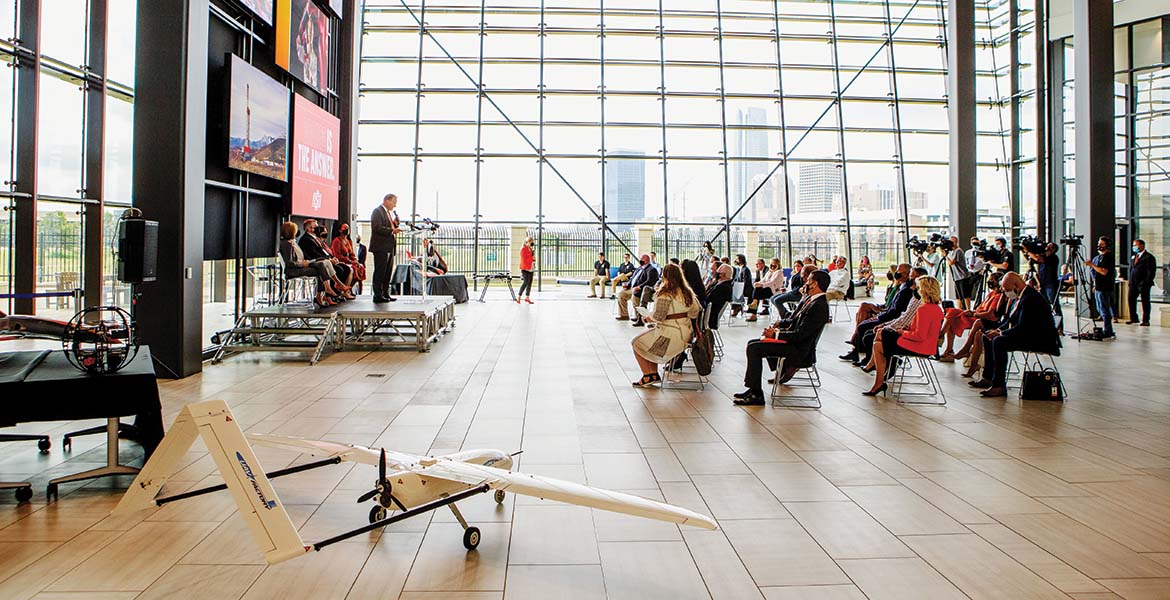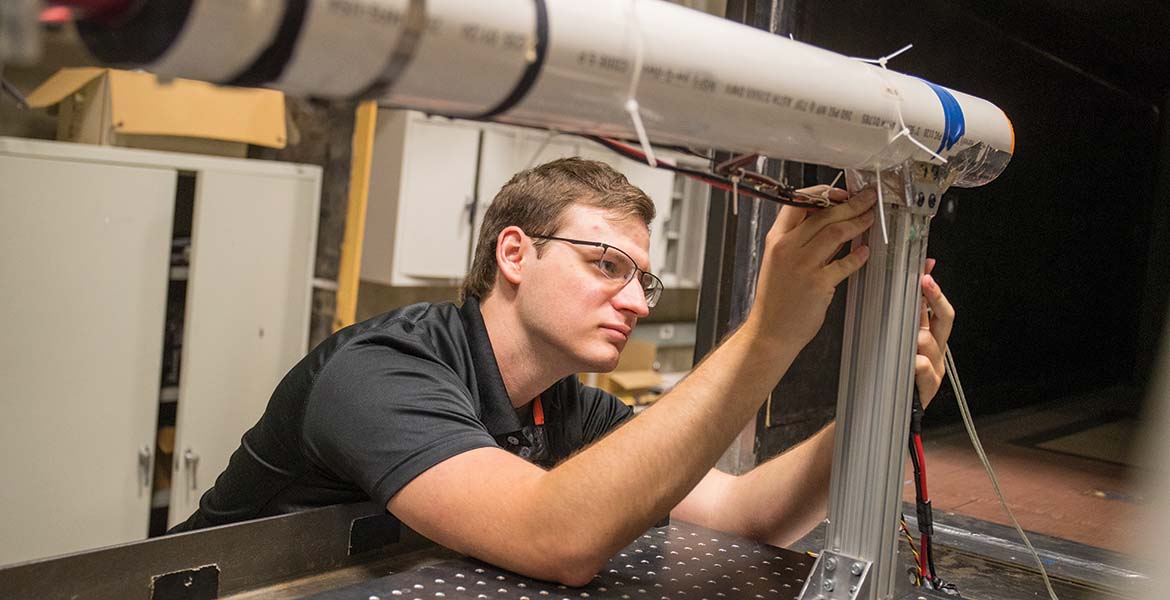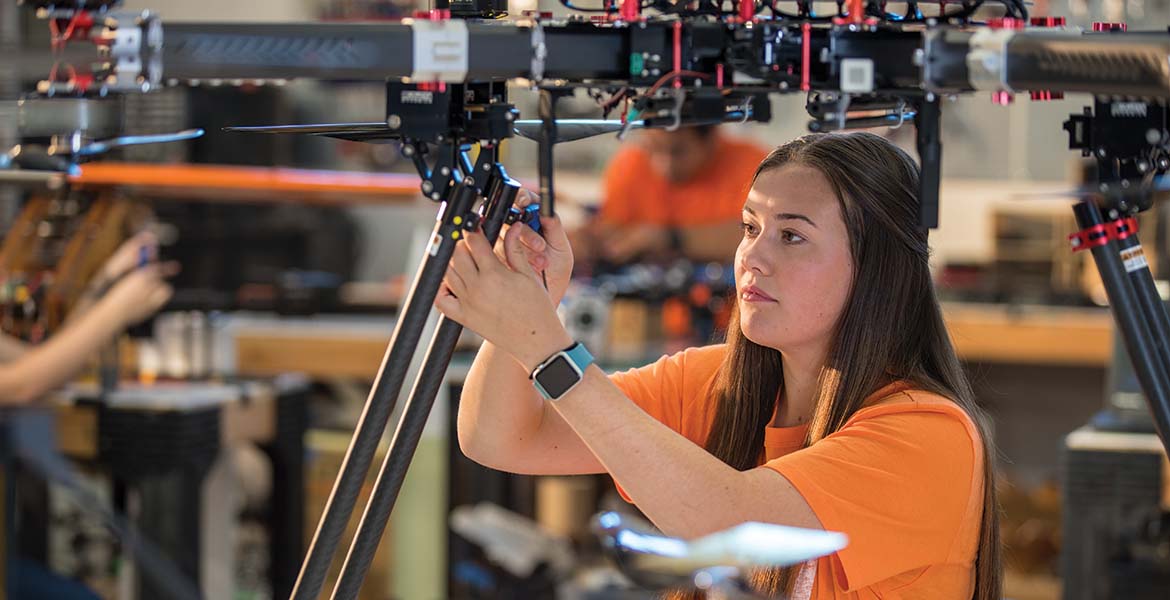
OAIRE makes OSU Oklahoma's aerospace leader
Tuesday, December 14, 2021
Media Contact: Mack Burke | Editorial Coordinator | 405-744-5540 | editor@okstate.edu
Already regarded as Oklahoma's aerospace leader, OSU is poised to expand its reach with the creation of a new institute that will bring the state's aerospace innovation economy together under one umbrella.
The Oklahoma Aerospace Institute for Research and Education (OAIRE) will support partnerships among university, commercial, military and governmental agencies and serve as a resource for developing the state’s aerospace ecosystem. That includes generating high-tech jobs and cutting-edge research that attracts commercial enterprise and military sustainment support. The comprehensive scope of OAIRE includes K-12 and higher education outreach programs focused on STEM connections, building the aerospace workforce pipeline and promoting community involvement.
Ready for Launch
At a special announcement ceremony in August at OSU DISCOVERY in Oklahoma City, Oklahoma State University President Kayse Shrum stressed the importance of driving cross-industry collaborations and why OAIRE will benefit Oklahoma businesses, schools and the state as a whole.
“Oklahoma State University offers a complete turnkey solution for Oklahoma’s aerospace industry needs,” Dr. Shrum said. “From K-12 enrichment and workforce development, through faculty and graduate research to groundbreaking innovations in industry partnerships, we are leading the state to advance this important economic engine.
“Today, we’re announcing the formation of the Oklahoma Aerospace Institute for Research and Education. Oklahoma State University is the clear leader in aerospace within our state. We’ve had a partnership with NASA for more than 50 years. We’ve been training pilots for more than 80 years. Our depth and breadth of knowledge, faculty and research investments cannot be matched. We’re so proud of this very long history in aerospace and aviation excellence.”

Oklahoma Secretary of Science and Innovation Elizabeth Pollard echoed Dr. Shrum’s excitement when she spoke at the launch announcement.
“The Oklahoma economy is at an inflection point,” Pollard said. “Disruptive technology is changing the face of every industry and forcing all states to reassess how best to compete and remain relevant in a knowledgebased innovation economy. Innovation is the key driver to economic growth and prosperity. It is critically important to Oklahoma’s future. It will grow and diversify our state economy, accelerate our state’s competitiveness and create large-scale, high-paying jobs for Oklahomans.
“[OAIRE] will be at the forefront of innovation in the aerospace realm, and I commend Oklahoma State University for their successful programs and continued partnerships with the state. Prominent research and development activity related to aerospace has been under way for decades at OSU, and with their leadership in this dynamic industry, Oklahoma will be wellpositioned to lead the ever-evolving aerospace frontier.”
Expanding Education
Aviation is one of the fastest-growing programs in OSU’s College of Education and Human Sciences. OAIRE will expand aerospace research and course offerings in Oklahoma City at OSU DISCOVERY and in Tulsa at the Helmerich Advanced Technology Research Center.
This will allow students greater access to OSU’s undergraduate and graduate programs, which will be tailored to meet the needs of the aerospace sector in the surrounding area. Professionals seeking aerospace-related degrees can take aerospace or systems engineering core courses in Oklahoma City, Tulsa or Stillwater.
For K-12 schools, programming will include technical training, career placement and entrepreneurial opportunities for student engagement and retention. OSU will prioritize outreach to Native American and other underrepresented K-12 students with the goal of developing a diverse talent pipeline for Oklahoma-based companies.
Dr. Cecilia Robinson-Woods, superintendent of Millwood Public Schools in Oklahoma City, said one of her major concerns is preparing students for future careers. She said partnering with OSU has been a tremendous help in showcasing opportunities for them. This summer, for example, OSU welcomed more than 1,500 students to STEM camps.

“This partnership with Oklahoma State and aerospace helps us tremendously in regard to assuring that we’ll be able to train teachers to prepare kids, and then giving kids opportunities to see jobs in these high-paying industries. We’re very, very excited for the partnership to add exposure, starting with the STEM camps this [past] summer. Sending 1,500 kids to just be exposed to what a career in aerospace or engineering or STEM would look like is an amazing start.”
Dr. Shelbie Witte, Kim and Chuck Watson Endowed Chair in Education, heads the School of Teaching, Learning and Educational Sciences. She believes OAIRE will provide partners with a plethora of opportunities to engage with research to address real-world problems.
“OSU and the College of Education and Human Sciences continue to show we are experts in bridging educational research and innovation with the lives of Oklahomans,” Witte said. “K-12 outreach programs are the hallmark of our land-grant mission at OSU. The work we do in teacher education and teacher preparation can be strengthened by our K-12 partnerships, and likewise, K-12 classrooms can benefit from our collaborations.”
Partnering to Reach New Heights
With the largest and oldest aerospace engineering program in the state, OSU has a storied history with aerospace, defense and aviation research. The university has longstanding research partnerships with the FAA, Air Force, Navy, Army, and Special Operations Command. OSU faculty members conduct research with such industry partners as Boeing, Pratt and Whitney, Kratos, Skydweller, Zivco, Frontier Electronics Corp., Vigilant Aerospace Systems, Toyota and many others.
Paul Tikalsky, dean of OSU’s College of Engineering, Architecture and Technology, said OSU has more than $80 million under contract just this year related to aerospace and aerospace education.
“OSU’s is the first aerospace program in the state and twice the size of any other,” Tikalsky said. “We continue to expand our faculty and research operations and are now teaching more than 500 undergraduates in just aerospace engineering and another 1,000 in related fields. OSU brings expertise to industry partners in everything from advanced propulsion systems to avionics, unmanned systems, aerostructures, cybersecurity, re-engineering, airfield design, human factors, pilot training and much more. The Oklahoma Aerospace Institute for Research and Education is part of the next generation of OSU and Oklahoma’s growing economy.”
"We continue to evolve and grow as an aviation program..."
Brenda Rolls, CEO of Stillwaterbased Frontier Electronics Systems, said the strength of OSU’s engineering programs remains an important factor in her company’s success, with roughly 90 percent of Frontier’s degreed employees coming from OSU.
“We congratulate Oklahoma State on this significant and game-changing initiative, and we look forward to the robust advancement of the aerospace and technology business sectors within Oklahoma,” Rolls said.
Breaking Barriers
Dr. Jamey Jacob, director of OSU’s Unmanned Systems Research Institute and a mechanical and aerospace engineering professor, believes OAIRE represents a natural extension of OSU’s push to break down silos in favor of multidisciplinary research and collaboration.
“We still want to do the same great work we’re doing now, but being able to encompass all things aviation and aerospace at OSU will create exciting new opportunities,” Jacob said. “OSU has a very rich aerospace history and tradition. One of the reasons that USRI is a Tier 1 Research Initiative is because it builds on that legacy, laying the groundwork for the great potential we see in the future. Aviation and aerospace are among the largest industries in the state, and OAIRE asks what can we do to help support that with our areas of expertise and all of the great ongoing research at OSU.”
Jacob said that includes not only the research at USRI but also the work of people like Dr. Susan Stansberry, who serves as principal investigator for OSU’s NSPACE project (NASA STEM Pathway Activities — Consortium for Education) and all of the faculty working on OSU’s world renowned pilot training program, just to name a few. OSU has partnered with NASA education for 54 years.

NSPACE is a $46 million, five-year cooperative agreement with NASA that has served over 542,000 K-20 students and over 107,000 teachers in 16 activities over the past four years. It also supports 68 employees at five space centers and NASA headquarters.
Additionally, Jacob said Oklahoma continues to attract more aerospace companies, such as Kratos Defense & Security Solutions, which is developing large-scale, autonomous drones for the military. Another is Skydweller Aero, a Spanish-U.S. company that established its global headquarters in Oklahoma City this summer and recently donated a storied electric motor to OSU.
“This is really a prime opportunity to fulfill our Tier 1 objective to engage in groundbreaking research while simultaneously supporting our landgrant mission to support the people and industry of Oklahoma,” Jacob said.
The Future
Dr. Jon E. Pedersen, dean of the College of Education and Human Sciences, said he’s excited to partner with OAIRE and what the new institute will mean for the future.
Pedersen sees OAIRE as another step in OSU’s aviation ascendency, a process that traces its roots back to the founding of OSU’s Flying Aggies in 1948 and all of the rich history associated with aviation in Oklahoma.
“We continue to evolve and grow as an aviation program, adding resources such as the Ray and Linda Booker OSU Flight Center, which is going to be superior to any other flight center in the nation,” he said.
“OAIRE is another unique resource that will continue to expand our efforts in aviation and allow us to continue to work collaboratively enhancing the learning and experiences through our aviation programs.
OSU Vice President for Research Kenneth Sewell said investing in and creating a center of excellence changes everything. OAIRE will allow research to continue year-round at speed. Whether it’s a proof of concept, a full prototype, or research and development, Sewell said OSU will be uniquely equipped to meet the challenge.
“This is not just dropping a name over it,” he said. “This is creating an infrastructure that makes it more of a 365 research operation. It’s not 24-7, but it’s essentially non-stop.
“Most university research is projectbased. In other words, you develop an idea, you write a grant proposal, submit that proposal, get it funded, hire the graduate students who are going to work on that proposal. You start the project, and you finish it. Rinse and repeat. Projects have a beginning, middle and an end, and you’re continually starting new projects. That makes it difficult to respond rapidly, particularly to industry needs.”
"It's not just one piece of aerospace. It's not just manufacturing, drones, defense or sustainment. It's what people in the industry call 'the whole stack.'"
Other benefits will flow as well.
"This also will allow us to hire professional engineers and researchers that will be a part of this entity without other responsibilities,” Sewell said. “So it augments our responsiveness so we’re not having to scale up every time we get a new project. We want to be scaled up constantly so we can respond to the needs of industry, as well as go after federal grants and funding sources that can support that in a sustainable way.
“We keep all of our great faculty experts. We’re not pulling them away from the classroom to focus full-time on research, nor are we disrupting our ability to be responsive to the private sector and the federal government.”
That’s the research side. On the education side, Sewell said OAIRE creates synergy across departments and programs.
“We have these research programs on one side of the house and these outreach programs on the other side. This allows us to marry those better, to make the STEM ed programs better while enriching the experience for our graduate students and our current students.”
Sewell said doing so also helps fill the state’s skilled labor pipeline for jobs in high demand. That effort starts with K-12 partnerships and continues throughout students’ college careers. Sewell said the K-12 outreach element of OAIRE will bring different kinds of students together and illuminate STEM possibilities at the next level.
“We see that as being a big part of that connection,” he said. “We operate programs on behalf of NASA, some of which are nationwide. We want to work with NASA and other agencies to expand those programs and do all that we can to inspire young people to pursue unique research opportunities at OSU.”
OSU’s summer STEM camps are already making an impact. For college students, the impact can be measured in graduation and retention rates.
“Students who are involved in research almost never drop out,” Sewell said. “The retention rate is enormous. So even just from the standpoint of keeping students engaged, this engagement effort is worth it.
“The other side of this is a twoway street for companies. Geographic regions that have strong relationships between their research universities and the private sector are an economic magnet for companies. They know they’re going to have a pipeline of workers and potential interns, and cultivating opportunities for graduates through these partnerships helps keep more talent right here in Oklahoma.”
Prime Location
Sewell said Oklahoma is already an attractive destination for aerospace companies. It’s a lot easier to get clearance to test a drone in a stretch of open prairie in Oklahoma than dense metropolitan areas. He said there’s also a military-friendly atmosphere in Oklahoma, business-friendly tax structures and unique opportunities to partner with Oklahoma’s tribal nations.
“The tribal communities with large land areas and the sovereignty over use of that land offer incredible testing grounds for some of these technologies,” Sewell said. “We’re partnering with the tribes, and so are these companies. It’s not just one piece of aerospace. It’s not just manufacturing, drones, defense or sustainment. It’s what people in the industry call ‘the whole stack.’
“We want to be diversified as a state economy and have expertise at OSU that spans the full spectrum of that ‘stack.’”
The timeline is dependent on resources, which are being secured at the university, state and federal level. In the meantime, Sewell said OSU and OAIRE are extremely well positioned to take on even more high level aerospace research, particularly the kind of practical research that has potential to change lives for the better.
“If anyone’s ever going to fly a drone at low altitudes to bring someone an Amazon package across a city like Atlanta, they’re only going to do it because in some place like Oklahoma, we’ve perfected the technology so that everybody, from the city officials to the FAA, is comfortable we’re doing that safely,” he said.
Aerospace Statistics
OSU produces 70% of the state’s aerospace engineering degrees.
OSU has the top aerospace engineering program in the state with more than 500 students enrolled and 80+ graduates per year.
OAIRE engineering faculty have completed more than $16.7 million in research in the past three years.
OAIRE faculty have ongoing aerospace engineering-related research awards of more than $33.8 million and aviation research and education-related awards that total over $4.8 million.
OSU has worked on projects with NASA for more than 50 years.
OSU is the lead of the NASA WINDMAP University Leadership Initiative team, a $5.2 million effort to develop weather monitoring and forecasting for advanced air mobility.
OSU leads NASA’s Oklahoma Space Grant and NASA educational programs, such as NASA’s Native Earth/Native Sky program aimed at tribal students and the NSPACE program, which provides competitive and innovative STEM educational opportunities to K-16 students and educators across the country.
Over the last 10 years, OSU’s aerospace engineering enrollment has grown over 62% (from 334 to 543 students).
Photos By: Gary Lawson and Phil Shockley
Story By: Mack Burke | STATE Magazine
